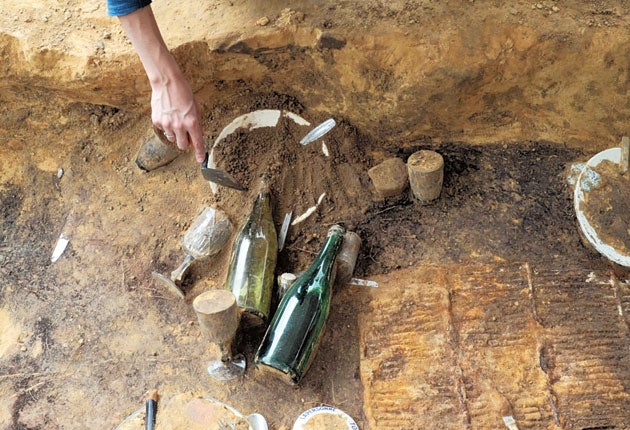Art of decay is revealed as buried banquet is dug up

Your support helps us to tell the story
This election is still a dead heat, according to most polls. In a fight with such wafer-thin margins, we need reporters on the ground talking to the people Trump and Harris are courting. Your support allows us to keep sending journalists to the story.
The Independent is trusted by 27 million Americans from across the entire political spectrum every month. Unlike many other quality news outlets, we choose not to lock you out of our reporting and analysis with paywalls. But quality journalism must still be paid for.
Help us keep bring these critical stories to light. Your support makes all the difference.
The banquet was buried in a picturesque chateau garden outside Paris 27 years ago, – a feast of tripe, smoked udders, veal lungs, pigs' ears and trotters. Now French archaeologists, more used to unearthing Roman coins and pottery shards, are painstakingly digging up these 20th century remains.
Back in April 1983, dozens of artists, gallery-owners, film directors and art critics were invited by the Swiss artist Daniel Spoerri to a sumptuous banquet of his favourite food. After the meal, instead of clearing the tables, the guests helped to carry them – still laid with cloths, plates, glasses and uneaten food – into a pre-dug trench 40 metres long and 1.3 metres deep.
Now the 80-year-old artist has returned to the site to see how his artwork has fared after three decades underground.
While cutlery, plastic glasses, ashtrays and bottles have been unearthed so far, the chipboard tables have petrified and the food remains have rotted away.
"We used lilac vases, to look bourgeois", the artist reminisced, while the Swiss photographer Peter Knapp took snaps of the dig. A guest at the original banquet, Mr Knapp remembered an "amusing" meal. "My wife didn't eat anything... Spoerri ate with 8cm doll's cutlery".
Daniel Spoerri is best-known for his "snare-pictures", where everyday objects, leftovers from meals or even whole flea-market stalls are fixed to a board or table, which is then hung vertically. In 2008, one such snare-picture – the remains of a meal eaten by the Surrealist artist Marcel Duchamp – was sold for over €136,000 (£112,000).
Mr Spoerri was also a founder of the Eat Art movement in the Sixties, which mixed food and artistic creation. In 1968 he opened the Restaurant Spoerri in Düsseldorf , where customers were served python stew and elephant trunk steak, or invited to make edible artworks.
Jean-Paul Demoule, one of France's top archaeologists, compared the dig to "garbage archaeology", an American-based movement using waste analysis to study society.
According to Mr Demoule, the unearthed banquet is also being used to study how different materials decompose and test new scientific processes. "We know what they ate, for example tripe... We're going to try and find the traces with experimental chemical analyses", he said.
Once the remains have been analysed by a dozen specialist laboratories, they will be exhibited at the Pompidou modern art museum in Paris. Mr Spoerri hopes the banquet can then be reburied for posterity.
Join our commenting forum
Join thought-provoking conversations, follow other Independent readers and see their replies
Comments